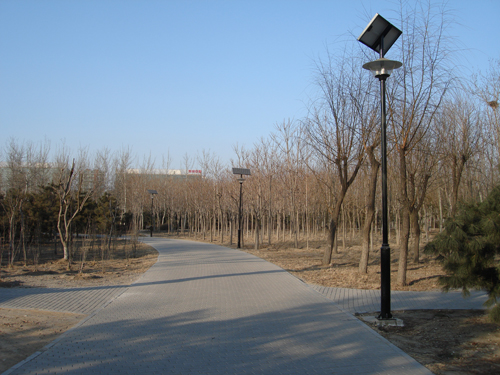Wed 20 Feb 2008
While the use of renewable energy technology is laudible, let’s focus a bit more on execution
Posted by + mOdOk + under Currents , Life in Beijing , Sustainability1 Comment

Solar powered lights in Beijing parks are great, but something is wrong with this picture!
While the finger-pointers in the West may look scornfully upon China as the biggest threat to global warming, despite that fact that many of China’s emissions are a direct result of offshoring by said finger-pointing countries in an effort sate the mindless consumerism of the local residents, who don’t want such dirty stinky polluting factories in their own back yards, especially as it wouldn’t be “environmentally friendly”, few may be aware that from a policy standpoint, at least, China is in many ways ahead of the pack. Now if we can only work on execution…
There is, sadly, a major disconnect between the lofty heights of academia and government, and the real world of practical implementation. I’m not even talking about the selfish money-centered attitude that manifests out of a universal human tendency to choose what it is good for an individual personally, even at the cost of the community as a whole. I’m talking about something far more fundamental. Knowledge takes time to trickle into human consciousness, despite the best intentions.
If you haven’t taken a good look at the picture above, please do so now, and see if you can find something wrong with the picture. At first glance, the picture can be seen as a true measure of progress… solar powered street lights using CFL lamps in a public park in Beijing. However, something went dreadfully wrong with the installation - a major disconnect between the supplier of the new technology and the park planners. Have you guessed correctly! Well done! Go to the head of the class.
For those of you who aren’t as familiar with the nuts and bolts of renewable energy technologies, take a look at the orientation of the solar PV panels atop each street light. They are all facing different directions! Some are facing in opposite directions!! Which means that they are working at a fraction of their capacity, as solar panels should be aligned for maximum exposure to solar radiation throughout the day, in a southward direction in the northern hemisphere. Ideally, the angle of the panel should be adjusted for the time of year, as the sun is much lower in the sky during the winter than in the summer.
Now, it could very well be that the designers of the panels have over-designed them to be able to operate in spite of such gross inefficiencies, but if this is so, then this too is simply inefficient. As solar panels are still rather costly to produce and come with an environmental price tag when considering their manufacturing process, as well as disposal and recycling, greater care and consideration should accompany their use.
So, what are your views? Am I overly critical? Not critical enough? You tell me.












